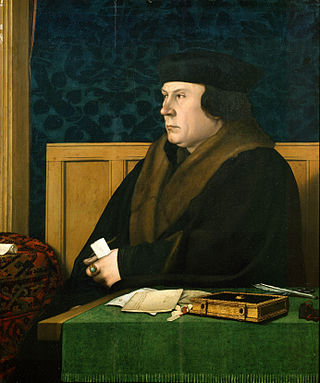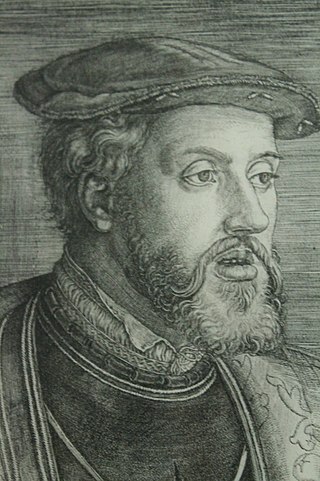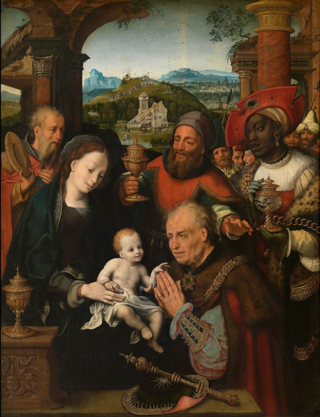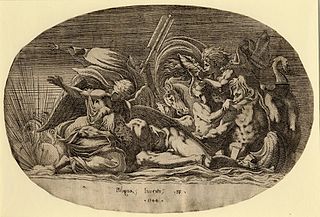
Thomas Cromwell, briefly Earl of Essex, was an English lawyer and statesman who served as chief minister to King Henry VIII from 1534 to 1540, when he was beheaded on orders of the king, who later blamed false charges for the execution.

Nocturnality is an animal behavior characterized by being active during the night and sleeping during the day. The common adjective is "nocturnal", versus diurnal meaning the opposite.

In art history, "Old Master" refers to any painter of skill who worked in Europe before about 1800, or a painting by such an artist. An "old master print" is an original print made by an artist in the same period. The term "old master drawing" is used in the same way.

The School of Fontainbleau refers to two periods of artistic production in France during the late French Renaissance centered on the royal Palace of Fontainebleau that were crucial in forming Northern Mannerism, and represent the first major production of Italian Mannerist art in France.

Alessandro Bonvicino, more commonly known as Moretto, or in Italian Il Moretto da Brescia, was an Italian Renaissance painter from Brescia, where he also mostly worked. His dated works span the period from 1524 to 1554, but he was already described as a master in 1516. He was mainly a painter of altarpieces that tend towards sedateness, mostly for churches in and around Brescia, but also in Bergamo, Milan, Verona, and Asola; many remain in the churches they were painted for. Most are on canvas, but a number even of large ones are on wood panel. Only a handful of drawings survive.
Active management is an approach to investing. In an actively managed portfolio of investments, the investor selects the investments that make up the portfolio. Active management is often compared to passive management or index investing.

Girolamo Francesco Maria Mazzola, also known as Francesco Mazzola or, more commonly, as Parmigianino, was an Italian Mannerist painter and printmaker active in Florence, Rome, Bologna, and his native city of Parma. His work is characterized by a "refined sensuality" and often elongation of forms and includes Vision of Saint Jerome (1527) and the iconic if somewhat anomalous Madonna with the Long Neck (1534), and he remains the best known artist of the first generation whose whole careers fall into the Mannerist period.

Barthel Beham (1502–1540) was a German engraver, miniaturist, and painter.

The Court of Wards and Liveries was a court established during the reign of Henry VIII in England. Its purpose was to administer a system of feudal dues; but as well as the revenue collection, the court was also responsible for wardship and livery issues.

Bishop John Hinchliffe DD was an English churchman and college fellow. He was Master of Trinity College, Cambridge, 1768–88, Bishop of Peterborough, 1769–94, and Dean of Durham, 1788–94.

Joos van Cleve was a leading painter active in Antwerp from his arrival there around 1511 until his death in 1540 or 1541. Within Dutch and Flemish Renaissance painting, he combines the traditional techniques of Early Netherlandish painting with influences of more contemporary Renaissance painting styles.

The artists of the Tudor court are the painters and limners engaged by the monarchs of England's Tudor dynasty and their courtiers between 1485 and 1603, from the reign of Henry VII to the death of Elizabeth I.
William More was appointed Bishop of Colchester to deputise within the Diocese of Ely under the provisions of the Suffragan Bishops Act 1534 in 1536 and held the post until his death in 1541. Educated at Cambridge University.

Catherine Howard, also spelt Katheryn Howard, was Queen of England from 1540 until 1541 as the fifth wife of Henry VIII. She was the daughter of Lord Edmund Howard and Joyce Culpeper, a cousin to Anne Boleyn, and the niece of Thomas Howard, 3rd Duke of Norfolk. Thomas Howard was a prominent politician at Henry's court, and he secured her a place in the household of Henry's fourth wife, Anne of Cleves, where she caught the King's interest. She married him on 28 July 1540 at Oatlands Palace in Surrey, just 19 days after the annulment of his marriage to Anne. He was 49, and she was between 15 and 21 years old.

The Master of Meßkirch was an anonymous German Renaissance painter.

Cornelis van Cleve, Cornelis van Cleef or Cornelis van der Beke, nickname Sotte Cleve was a Flemish Renaissance painter active in Antwerp who is known for his religious compositions and portraits. Starting his career in Antwerp in the workshop of his father Joos van Cleve, he later worked for a while in London. When he failed to achieve success in England, he became insane and stopped painting.

Antonio Fantuzzi was an Italian painter and printmaker active in the French Renaissance in a Mannerist style. All that is known about his early life is that he was born in Bologna, from the accounts at Fontainebleau and one inscription on a print.
ERB-79 is a synthetic estrogen and a selective agonist of the ERβ. It is a racemic mixture, with the active enantiomer being ERB-26. ERB-79 shows more than 484-fold selectivity for transactivation of the ERβ over the ERα. Its EC50 value for the ERβ is 0.448 nM (14.52% of the potency of estradiol) and for the ERα is 79 nM (0.03% of the potency of estradiol). It has no antagonistic activity at either receptor. ERB-79 is active in preclinical models of arthritis. The chemical structure of ERB-79 does not appear to have been disclosed.

Léon Davent was a French printmaker in the mid 16th century, closely associated with the First School of Fontainebleau. He worked in both engraving and etching and many of his works are based on designs by Francesco Primaticcio, "rendered boldly and freely". Others use designs by Luca Penni and other artists. It is thought that there was a workshop at the Palace of Fontainebleau itself in the 1540s, where he was one of the leading printmakers. Their main purpose seems to have been to record the new style being forged at Fontainebleau, copying both the main subject paintings and the elaborate ornamental stuccos and other decorations.
















